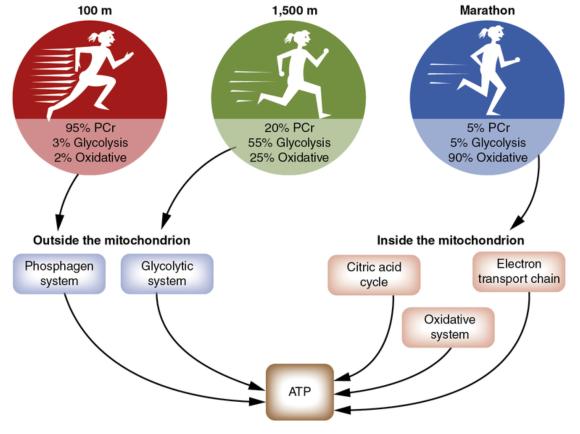Energy Systems
This is an excerpt from Essentials of Obstacle Race Training, The by David Magida,Melissa Rodriguez.
Simply put, energy is the ability to do work, and this includes all human movement and activity. (And you will need a lot of it to get you through not only an obstacle course race but also the challenging training sessions leading up to your event.) Energy systems refer to the specific mechanisms in which energy is produced and used by your body. Like most mammals, you generate energy via three systems: phosphagen (ATP-PC), glycolytic, and oxidative (see figure 2.1). All three energy systems are engaged during all forms of physical activity. However, the extent to which each one is involved varies depending on the duration and intensity of the activity. To train effectively, an athlete engages specific energy systems relevant to the activity of choice; in your case, it's obstacle racing. Let's review all three energy systems as listed in figure 2.1.

Energy systems.
Phosphagen System
First is the phosphagen (ATP-PC) system. If you remember biology class in high school, you recall that ATP, short for adenosine triphosphate, is a molecule that provides energy for all movement. Your body breaks down ATP to fuel your every move, from standing up to climbing a race wall. The phosphagen energy system harnesses ATP for highly intense activities that last 10 to 30 seconds. So for explosive activities like leaps over fire or jumps over a barrier in OCRs or sprints and plyometric exercises in your training sessions, your body is predominantly engaging the phosphagen system for energy. Since your body stores a limited amount of ATP, activities lasting more than 30 seconds must also tap into energy generated by the glycolytic system.
Glycolytic System
The glycolytic system uses carbohydrate to produce ATP. Activities lasting 30 seconds to 3 minutes are primarily fueled by energy produced by this system. Think of boxing rounds, which last 1 to 3 minutes. Soon, in your training, you will complete similar brief circuits, intervals, and drills to prepare you for some of the short, intermittent bouts of obstacles you'll face along a course, such as hauling a heavy object a hundred feet or negotiating a horizontal Tyrolean traverse over a stretch of shallow water. After a few minutes of sustained activity, your body starts to rely on the oxidative system to help meet your energy needs.
Oxidative System
Unlike the phosphagen and glycolytic system, the oxidative system is aerobic and uses oxygen to help with energy production. While the glycolytic system uses carbohydrate to generate energy, the oxidative system dips into other macronutrients as well: fat and protein. (You'll learn more about macronutrients in chapter 4.) The oxidative system is heavily engaged in low- to moderate-intensity activities. You'll harness a lot of energy via the oxidative system for your longer training sessions, including distance running. You'll also rely on the oxidative system to fuel you through the length of any obstacle race, from a 5K to a 12-miler.
Unlike the demands of some sports, the challenges you'll face in an obstacle race are multifaceted. For example, a football lineman does not need to train in the oxidative system as much as an OCR athlete because of sport specificity. To prepare for the quick bursts of blocking and tackling demanded by the sport's position, a lineman may spend most of his training time engaging the phosphagen and glycolytic energy systems. However, this athlete may still engage the oxidative system for overall health and conditioning.
As an obstacle athlete, your training will give you the benefits of both worlds: increased sport performance and improved overall health. You will take on challenges through your exercise regimen that will engage all three energy systems. Speed, power, and explosive exercises and drills target the phosphagen system. Total-body circuits focus on the glycolytic system. Longer training sessions tap into the aerobic system. By targeting all three energy systems, you'll greatly improve your overall fitness and sport-specific conditioning.
Keep in mind that all energy systems are active at all times during activity. Your body stores a limited amount of ATP, so the three energy systems work together to provide the energy you need in order to keep moving. The extent to which each one is engaged varies depending on the duration and type of activity, whether it's an explosive move or sustained exertion over time. As you will soon see, the regimen outlined in this book will help your body improve its ability to train in all three energy systems so you'll be in race-ready shape.
Which System Matters?
So as an obstacle athlete, which system do you target? All of them. An obstacle course race requires that you engage all three energy systems at varying levels throughout the race. To get through the distance of a race, you'll engage the oxidative system. To conquer a sharp, steep hill, you may need to tap into the glycolytic pathway, whereas a quick series of jumps call for rapid ATP production via the phosphagen system.
Learn more about The Essentials of Obstacle Race Training.
More Excerpts From Essentials of Obstacle Race Training, TheSHOP

Get the latest insights with regular newsletters, plus periodic product information and special insider offers.
JOIN NOW


